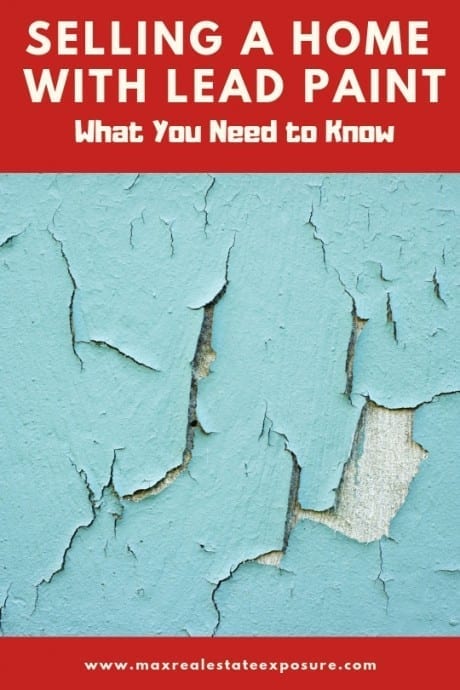Buyers, Sellers, and Real Estate Agents Need to Know The Lead Law
 Was the home you are going to be selling built before 1978? If so, chances are there is at least some lead paint present in the house.
Was the home you are going to be selling built before 1978? If so, chances are there is at least some lead paint present in the house.
The older the home, the more lead you can expect to find.
Buying and selling a home with lead paint can present some challenges you should be aware of.
Fortunately, they are relatively easy to overcome if you are well informed about your legal obligations.
If you are buying or selling a home where lead paint exists, you should know the law surrounding it.
There are many nuances to buying or selling a house where lead paint lives.
It is the only federally mandated disclosure when selling a house. Other types of disclosure issues are governed on a state-by-state basis.
All real estate agents must comply with the lead paint law.
Why Lead Paint is an Issue
Lead paint was used in most homes built before 1978. Although the lead content in the paint was reduced as the years moved closer to the 1978 cut-off, there is still enough lead present to be a problem for the health of anything that ingests or inhales it.
Lead is a highly toxic substance that affects nearly every organ in the body.
Children six years and younger are those at the most risk because they are more likely to consume the paint in their explorations. But lead can also vaporize and be inhaled when windows painted in lead-based paint are opened and closed.
Lead in the paint can leach into the non-lead-based paint as well, so painting over lead-based paint with modern paint is not enough to eliminate the risk.
If children ingest a new top layer of paint, they can still be affected by lead.
Younger children with an affinity for chewing have been known to eat trim around window sills and doorways. Doing so, of course, is a significant health threat causing lead poisoning. The reference gives an extensive list of symptoms of lead poisoning.
In 1992, legislators determined that lead-based paint in homes should be disclosed before selling. They passed the Lead Law, which dictates how homes with lead paint should be dealt with for all the main parties of concern—sellers, buyers, rental owners, renters, real estate agents, etc.
In Massachusetts, the notification program started in 1988. Another name for the lead transfer form is the Childhood Lead Poisoning Prevention Program.
Selling a Home with Lead Paint—What You Need to Know
Let’s examine the essential points to know about a home sale with lead paint.
1. You Must Disclose Any Information About Lead Paint In The Home.
 The critical thing you need to remember is that you must tell buyers if you know of any lead-based paint in the home or any hazards presented by lead-based paint.
The critical thing you need to remember is that you must tell buyers if you know of any lead-based paint in the home or any hazards presented by lead-based paint.
Quite often, sellers or landlords do not know if the house has lead paint.
In cases where the seller is not sure there is lead paint, they will sign off saying they do not know lead paint is present (if that is the case.)
Of course, if the seller knows there is lead paint in the property, they must disclose this fact.
There are a few things that the seller could provide, including:
- A lead inspection report that details where lead exists in the house.
- A risk assessment report.
- A letter of interim control.
- A letter of compliance with the lead paint law. The document of compliance will show your house as lead-free.
2. Buyers and Sellers Do Not Have to Test For Lead-Based paint.
While you most certainly have to disclose your knowledge of lead-based paint in the home, you do not have to test for the presence of lead-based paint.
If you haven’t done a test and no one told you there is lead paint, you are not forced to test.
A certified lead-free home, however, is easier to sell. Having a lead-free home alleviates the fear of buyers with children that the property could be a health risk.
3. You Must Give Buyers Ten Days to Test For Lead-Based Paint.
You do not have to have your home tested for lead-based paint, but you do have to give any potential buyers ten days to conduct their test.
If your property sells under a tight time frame, it is possible to negotiate a shorter testing window than ten days. Buyers may or may not have lead paint on their house inspection checklist. If buyers have older children, they are less likely to test.
4. Give Buyers a Property Transfer Lead Paint Notification.
Federal and Massachusetts laws require that sellers give prospective buyers a Property Transfer Lead Paint Notification before the buyer signs a purchase and sale agreement.
The notification explains the main points all parties must be aware of concerning the Lead Law. Everyone involved in the transaction must sign the agreement, which includes the buyer, seller, seller’s agent, and the buyer’s real estate agent.
The seller should fill out the lead paint form used in the transaction. The listing agent should give this form to the buyer before or when the offer to purchase is written.
A buyer’s agent should NEVER fill out a lead paint form and give it to the buyer. Doing this means a real estate agent is not compliant with the lead paint law!
Of course, your Realtor should be well aware of these requirements and hopefully has explained most of this to you before listing your home.
5. You Must Bive Buyers The Pamphlet, Protect Your Family from Lead in the Home.
The Property Transfer Lead Paint Notification is not the only form you need to be aware of as a seller.
You are also required to give potential buyers a pamphlet explaining the presence of lead in the home, who is at risk, and what the new owners can do to minimize the potential harm the lead paint could cause.
The pamphlet, Protect Your Family from Lead in the Home is available on the Environmental Protection Agency (EPA) website. The package is for both the state and federal lead notification requirements.
Following the lead paint law is critical as a real estate agent - make sure you do!Click To Tweet6. Make Sure You Meet The Lead Law Requirements.
Homeowners and real estate agents who do not follow these requirements can face a civil penalty of up to one thousand dollars under state law, a civil penalty of up to ten thousand, possible criminal sanctions under federal law, and liability for any damages incurred.
What is The Penalty For Not Disclosing Lead Paint?
The lead paint law is something to take very seriously as a buyer, seller, and real estate agent. There have been lawsuits where damages were in the hundreds of thousands for lead paint contamination.
The Director of the Office of Lead Hazard Control and Healthy Homes, or their designee, can initiate a civil money penalty action against any party who knowingly violates 42 U.S.C. 4852d.
The maximum penalty for not disclosing known lead paint is $19,507 for each violation.
How to Make Selling a Home with Lead Paint Easier
 If you are worried about the difficulties that may come up when trying to sell your home with lead paint, you are not alone.
If you are worried about the difficulties that may come up when trying to sell your home with lead paint, you are not alone.
To feel concerned, you only have to read a little about the risks of lead paint, particularly to children.
You don’t want anyone to come to harm due to buying your home. It is normal to worry about the risks the lead paint may pose to new buyers and how potential buyers will see your home.
Will they avoid it at all costs? Will you struggle to sell your home for a reasonable price or to sell your home at all?
While it is understandable to feel some concern, try not to get too worried. There are plenty of reasons why buyers will be interested.
You can sell your home and probably get a reasonable price for it. Here are some reasons why:
Most Homes Built Before 1978 Contain Lead Paint.
This is probably the most crucial point to remember. If people didn’t buy homes with lead paint, no one with an older home would be able to sell it.
While the exact number of older homes sold each year would take more research than is necessary for this article, you can guarantee that many older homes are sold year after year.
Some buyers specifically seek to purchase an older home for its charm and character. Any house built in the 1700s, 1800s, and 1900s up to 1978 has lead paint.
Just take a minute to add up the number of homes built before 1978, and you’ll realize it’s significant.
Do All Homes That Were Built Before 1978 Have Lead Paint?
No, they do not. However, the likelihood that a home has lead paint increases the further you get from 1978.
Older residences are more likely to be riddled with lead-based paint.
For instance, most pre-war residences feature lead-based paint; conversely, 24% of those constructed between 1960 and 1978 contain lead-based paint.
Lead-based paint may be present in residential dwellings, from single-family homes to apartments or condominiums.
Some Buyers Want Older Homes Whether There is Lead Paint or Not.
Not everyone is interested in buying new construction or young resales. Plenty of buyers find new homes boring and lacking in character.
Older homes tend to be of great interest to these kinds of buyers. When someone is looking for an antique home, they know to expect lead paint.
While lead paint can be an issue, there are usually more pressing concerns when buying an older house. As a seller, you should never lightly treat known issues with your home.
Do what you can and fix any glaring deficiencies. Getting ready for the buyer’s inspection before it takes place is always sound advice.
Not Every Buyer Has Young Children or Plans to Have Children.
The most significant risk posed by lead-based paint in a home is for children. Many buyers do not have young children or plan to have kids any time soon.
Older buyers, buyers with older children, and buyers who do not expect to have children are all likely to accept a house with lead-based paint without missing a step.
A skilled Real Estate Agent Knows How to Sell Homes With Lead-Based Paint.
Any reputable real estate will probably have experience selling homes with lead-based paint.
A good agent will be able to explain the many benefits of purchasing your home to buyers—benefits that far outweigh the inconvenience of having old paint in the house.
Professionals Can Remove Lead-Based Paint.
If lead-based paint is a problem for buyers, they can permanently remove it professionally. While an obvious expense is involved, it is the cost many buyers will happily cover.
They can remove the lead paint and add new paint if they want the home.
Some sellers ask if they remove the lead paint will make their property more valuable. The answer is yes, having a deleaded house will change the value.
A lead-free home more than likely means you have replaced old windows and doors. You would have more energy-efficient windows and doors, which many energy-conscious buyers love.
Adhering to The Lead Paint Law is Not Difficult.
The Lead Law is relatively easy to follow for sellers. You don’t even have to get your home tested for lead paint. You have to let buyers know what information if any, about the paint in your home, hand them a few pamphlets, and sign a document together.
Regarding the challenges of selling a home, dealing with lead-based paint is relatively simple.
Buying a Home with Lead Paint—What You Need to Know
 Are you buying a house with lead paint? Buyers have a different responsibility than sellers regarding lead paint removal.
Are you buying a house with lead paint? Buyers have a different responsibility than sellers regarding lead paint removal.
It must be removed if you are purchasing real estate with a child under six, where lead paint exists.
Buyers must either have the property deleaded or brought under interim control within 90 days of purchase if a child under six is living in the home.
1. Buyers Are Not Required to Test For Lead Paint.
When purchasing a home, buyers are not required to test for lead paint, even if they have a child under six.
Over the thirty-seven years I have been selling real estate, there have been times when buyers would be faced with the dilemma of testing or not.
On the one hand, buyers will want to know if their home is safe.
On the other hand, there will be trepidation in finding out if their dream house has lead paint, especially if they have a tight budget.
Removing lead paint from a home is not cheap and could cause a buyer not to move forward.
In my experience, more times than not, buyers pass on having a lead paint test done.
2. Lead Paint Inspection Near Me
There are a few ways to find a lead paint inspector. The first is asking your real estate agent for a referral. If your agent doesn’t know any lead paint inspectors, it is likely your general home inspector will. Ask them for a referral.
The last method you can try is a Google search for lead paint inspection near me. You should see several results for lead paint inspectors nearby.
You can also ask your home inspector if they suspect there is lead paint.
3. What Does a Lead Paint Inspection Cost?
You can expect a lead paint inspection to cost between $250-$450. It will vary based on where you are located and the size of the home.
Like the cost of a home inspection, it is worth having peace of mind for you and your family when buying a house.
4. Who Pays For a Lead Paint Inspection?
In most residential real estate sales, the buyer will bear the cost of a lead paint inspection. It is possible that a buyer could negotiate for a seller to pay for it.
5. Should I Waive The Lead Paint Inspection?
Whether to waive a lead paint inspection is a personal decision. It would be best if you did what makes you comfortable.
6. If a Home Has Lead Paint, What Do You Do?
Once you take possession of the home via transfer of title and there is a child under six present, you must get rid of the lead paint or follow interim control protocols.
7. What is Interim Control, and How Does it Work?
Interim control is a temporary fix for lead paint hazards in a home. It is different from a complete deleading because it only deals with the worst lead paint issues.
These lead hazards are considered the following:
- Loose, chipping, or peeling paint
- Windows that have lead paint that is shedding dust or chips
- Dust in the house containing high lead levels
- Window wells that are not smooth or easy to clean
- Structural defects in the house, like roof or plumbing leaks that are making lead paint peeling
To be approved for interim control, the following conditions must be met:
- You must hire a licensed risk assessor. The risk assessor will identify lead hazards and show you what work must be completed.
- After the work is done, the risk assessor must return to the house to take dust samples and visually inspect if the work has been done correctly.
- If a house meets interim control standards, the risk assessor will issue a Letter of Interim Control, which is good for one year.
An owner can have the home reinspected before the end of the year. If the house still meets all the conditions of Interim Control, the Letter of Interim Control may be renewed for one additional year.
By the end of two years, the house must comply with the lead paint law.
8. Who Can Do Lead Paint Interim Control Work?
 Under interim control, licensed de-leaders must do some work and repairs. Homeowners and their agents may do low and moderate-risk work if they have undergone specialized training.
Under interim control, licensed de-leaders must do some work and repairs. Homeowners and their agents may do low and moderate-risk work if they have undergone specialized training.
Contact the Childhood Lead Poisoning Prevention Program (CLPPP) for more information on what repairs a homeowner can and cannot do.
Here is an excellent resource for finding companies certifying inspections, risk assessments, and lead paint abatement. To find these lead experts, you can put the state where you are located.
9. Can I Encapsulate The Lead Paint in My House?
The answer is yes. Encapsulating is a legal method of dealing with lead paint.
Encapsulation provides a special liquid coating and a long-lasting, effective barrier over lead paint. Regular paint is not encapsulated.
Encapsulation can only be used on surfaces that are in good condition. Encapsulation will not work on surfaces that are badly deteriorated, are walked on, or are subject to friction.
To do encapsulation work, you don’t need to be a licensed lead remover. However, you must review a brief training booklet and take an at-home test.
You are required to bring the at-home test to the Massachusetts Childhood Lead Poisoning Prevention Program (CLPPP). You will receive an authorization number to apply the encapsulants.
Here is some excellent info on lead encapsulation products.
10. What to Know About Lead Paint Encapsulation
Encapsulants are substances that can be applied to safeguard lead-based paint against becoming detachable and thereby reducing exposure to airborne particulate.
The encapsulants can be either liquid or adhesive. The result is that encapsulation provides a barrier between the paint and the property’s interior.
Three Common Types of Encapsulates
Polymers of impeccable quality are utilized to construct a pliable, resilient membrane. This can be achieved through various methods, including applying a brush, roller, or airless sprayer.
Enduring, hard, but pliable surfaces are attainable using epoxy or polyurethane polymer coatings. These adhesives can be applied by hand-applying a brush, roller, or airless spray gun – all methods yield sturdy yet malleable constructions.
There are also cement-like materials with polymers that bond to provide a thick coating. They are usually applied with a trowel.
This excellent resource explains everything to know about lead paint encapsulation.
11. Does The House Need to Be Vacant When The Deleading Work is Done?
Unfortunately, you must be out of the house the entire time a deleading specialist removes lead paint.
You may stay at home but out of the work area while a de-leader or property owner without a de-leaders license does some deleading tasks or such interim control work as structural repairs or lead dust cleaning.
You cannot return to the home until the lead removal work is complete, the house is cleaned, and the risk assessor has found the work to be done satisfactorily.
12. Is There Any Financial Assistance For Deleading a House?
There is a state income tax credit of up to $1500 per unit for full deleading. A credit of up to $500 per unit is also available for interim control work that contributes to complete lead removal.
You will need to check your state to determine if any deleading assistance is available.
13. Buying a Multi-Family Investment Property With Lead Paint
When you are purchasing a multi-family that you discover has lead paint, it can be problematic. Let me give you a scenario to think about. You decide to buy an older multi-family property in which you plan to live. You conduct a lead paint test and find out there is lead paint.
There is currently a tenant in the other unit that has a lease with a child under six. You are now responsible for removing the lead paint from the tenant’s unit.
You are responsible for removing the lead and finding alternative housing for the tenant, and paying for it. Yes, you are reading this correctly.
The landlord is responsible for paying the tenants reasonable moving expenses and temporary housing costs over and above the rent of the house being deleaded.
When the lead is removed from the home, the tenant is still responsible for paying the rent.
The costs are high in situations such as these. If you’re buying a home under this scenario, it would probably make sense to negotiate some of the costs with the current seller.
Not long ago, I was involved in this exact situation with a home in Hopedale, Massachusetts. Understanding the nuances of the lead law comes in handy.
Other Helpful Articles on Potential Hazards in a Home
- What to know about buying and selling a house with mold? Mold is common in homes and easily remedied.
- What to know about buying and selling a home with radon. Radon levels in the air above four pCi/L are considered worth remediating.
- What to know about buying and selling a home with radon in the water. Radon in the water is more expensive to remediate than in the air.
- What to know about buying and selling a house with asbestos. Asbestos is a hazardous substance that needs to be safely contained.
Final Thoughts on Buying and Selling Homes With Lead Paint
All parties involved in a real estate transaction should understand the lead paint law. Without knowing the lead law, you put yourself at risk of a lawsuit and significant financial damages.
Whether in Massachusetts or another state, lead paint is something to take seriously.
Additional Articles on Buying and Selling Worth Reading
- Prepare your home for severe storms – Jamohl DeWald offers guidance on storm preparation.
- Inspection tips when purchasing a home – Luke Skar provides practical considerations about home inspections.
- Real Estate myths to ignore – Karen Highland discusses things in real estate that is not true.
- What to think about when the buyer backs out – Lynn Pineda shares guidance on what to do when a buyer backs out of a home sale.
Use these additional helpful resources to make great decisions when buying or selling a house!
About the Author: The above Real Estate information on buying and selling a house with lead paint was provided by Bill Gassett, a Nationally recognized leader in his field. Bill can be reached via email at billgassett@remaxexec.com or by phone at 508-625-0191. Bill has helped people move in and out of many Metrowest towns for the last 37+ Years.
Are you thinking of selling your home? I am passionate about real estate and love sharing my marketing expertise!
I service Real Estate sales in the following Metrowest MA towns: Ashland, Bellingham, Douglas, Framingham, Franklin, Grafton, Holliston, Hopkinton, Hopedale, Medway, Mendon, Milford, Millbury, Millville, Natick, Northborough, Northbridge, Shrewsbury, Southborough, Sutton, Wayland, Westborough, Whitinsville, Worcester, Upton, and Uxbridge MA.

